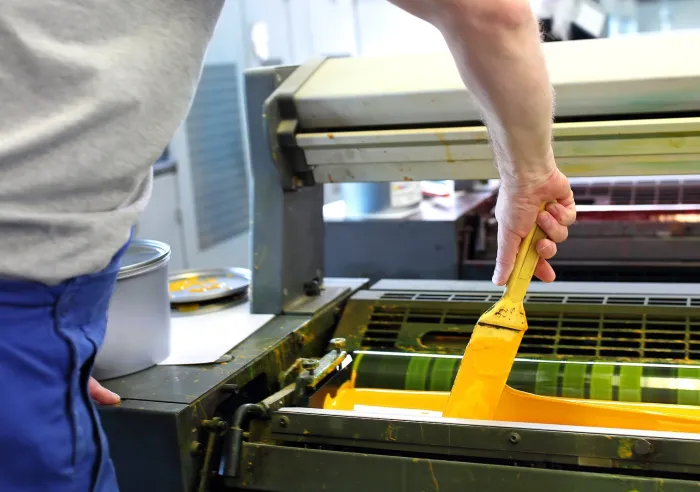When it comes to offset printing, a widely used technique in the printing industry, one of the most common issues faced is ink drying problems. These problems can lead to smudging, set-off, and other quality issues that can affect the final product. Understanding these challenges and how to address them is crucial for anyone involved in the printing process, especially marketing professionals who rely on high-quality print materials.

Understanding Ink Drying in Offset Printing
Offset printing involves transferring an image from a plate to a rubber blanket, and then to the printing surface. The ink used in this process is typically oil-based, which presents unique drying challenges. Unlike digital printing, where the ink is fused or cured almost instantly, offset ink requires time to dry. This drying process is influenced by several factors, including the type of ink, the printing surface, and environmental conditions.
Factors Affecting Ink Drying
Several factors can influence the drying time of ink in offset printing:
- Ink Formulation: The composition of the ink, including the type of oil and pigment used, can significantly affect drying time.
- Paper Type: Coated papers tend to slow down the drying process, while uncoated papers allow for faster absorption.
- Environmental Conditions: Humidity and temperature in the printing environment can also impact drying times.
Common Ink Drying Problems in Offset Printing
Understanding the common issues related to ink drying can help in effectively addressing them:
1. Set-Off
Set-off occurs when wet ink transfers from one sheet to another. This often happens when sheets are stacked before the ink is fully dried. To mitigate this, printers can use anti-set-off powders or allow longer drying times.
2. Smudging
Smudging occurs when the ink is disturbed before it dries. This can be due to handling or poor stacking. Ensuring proper handling and using quick-drying inks can help prevent this issue.
3. Ghosting
Ghosting is a subtle defect where unwanted images appear on the print. It often results from uneven ink distribution or insufficient drying. Adjusting ink flow and improving drying conditions can help resolve this.
Solutions to Ink Drying Problems
Addressing ink drying problems requires a combination of proper techniques and adjustments:
Optimizing Ink Formulation
Choosing the right ink formulation is crucial. Printers can opt for inks with faster drying times or those that are designed for specific paper types.
Adjusting Environmental Conditions
Regulating the humidity and temperature in the printing area can help speed up the drying process. Using fans or heaters can also assist in reducing drying times.
Utilizing Drying Aids
Incorporating drying aids such as infrared dryers or UV coatings can significantly enhance the drying process, ensuring that the ink sets quickly and effectively.
Preventing Ink Drying Problems
Prevention is always better than cure. Here are some preventive measures:
Proper Stacking Techniques
Ensuring that printed sheets are properly stacked with enough space for air circulation can help prevent set-off and smudging.
Regular Maintenance of Printing Equipment
Regular maintenance of printing equipment ensures that ink distribution is even and drying is consistent.
Training and Knowledge
Training operators on the latest techniques and technologies in offset printing can help in effectively preventing and addressing ink drying problems.
Impact on Marketing Professionals
For marketing professionals, the quality of print materials is crucial. Issues like smudging and set-off can affect the brand’s image and the effectiveness of marketing campaigns. Ensuring high-quality prints not only enhances the brand’s reputation but also ensures that marketing messages are communicated effectively.
Conclusion
Understanding and addressing ink drying problems in offset printing is essential for producing high-quality print materials. By optimizing ink formulations, adjusting environmental conditions, and employing preventive measures, these issues can be effectively managed. For marketing professionals, ensuring that print materials are of the highest quality is crucial in maintaining brand integrity and delivering impactful marketing campaigns. To further explore the intricacies of offset printing, you can visit this comprehensive guide on offset printing.
Related Articles
For more information on other offset printing challenges, you might find these articles useful: Troubleshooting Offset Issues, Offset vs. Laser Printing, and Offset Printing for Magazines.

FAQs
What causes ink drying problems in offset printing?
Ink drying issues can be caused by various factors, including ink formulation, paper type, and environmental conditions.
How can I prevent set-off in offset printing?
Prevent set-off by using anti-set-off powders, allowing longer drying times, and ensuring proper stacking techniques.
Are there quick-drying inks available for offset printing?
Yes, there are quick-drying inks available that are formulated to reduce drying times and improve print quality.
This article contains affiliate links. We may earn a commission at no extra cost to you.






